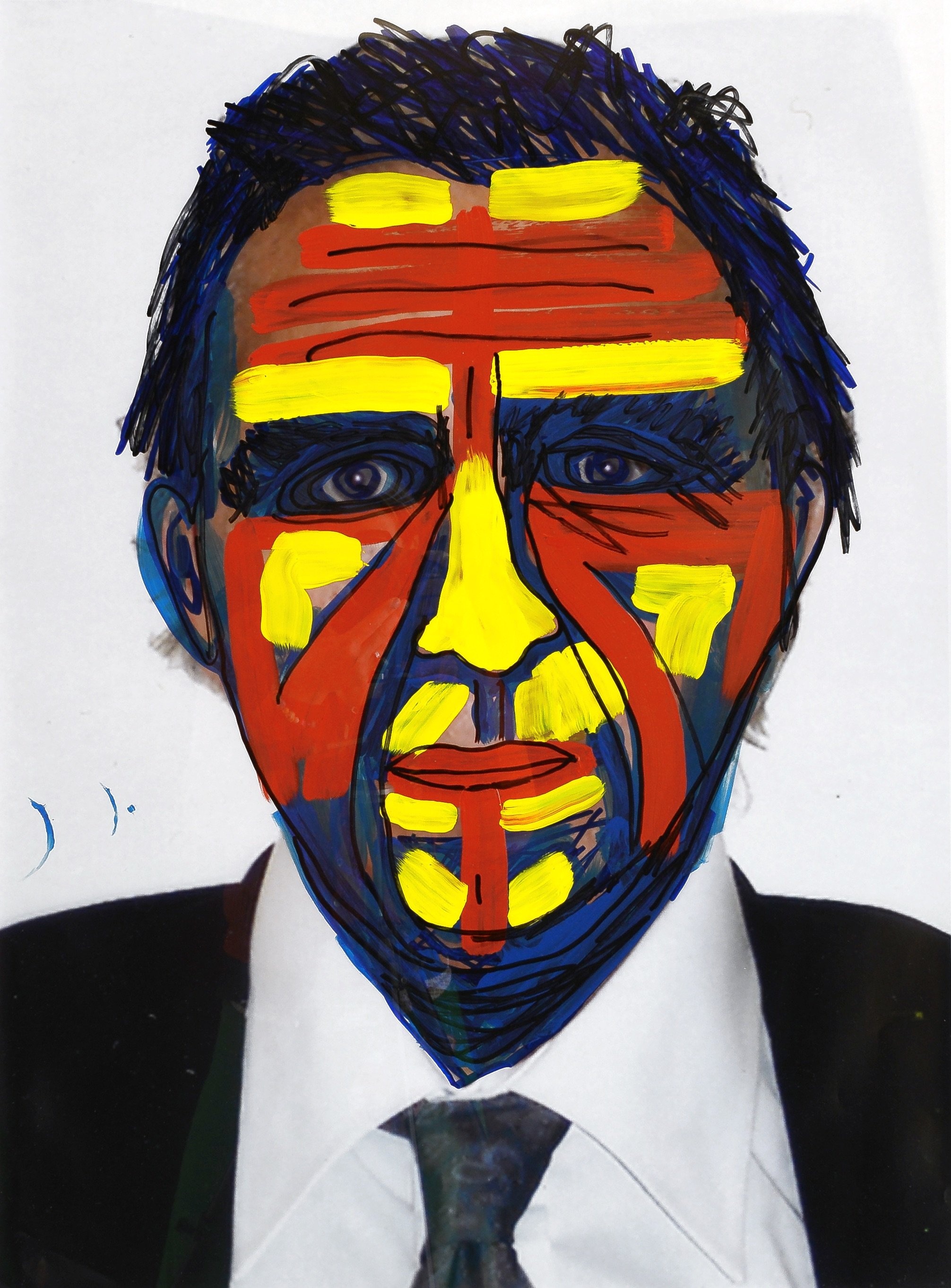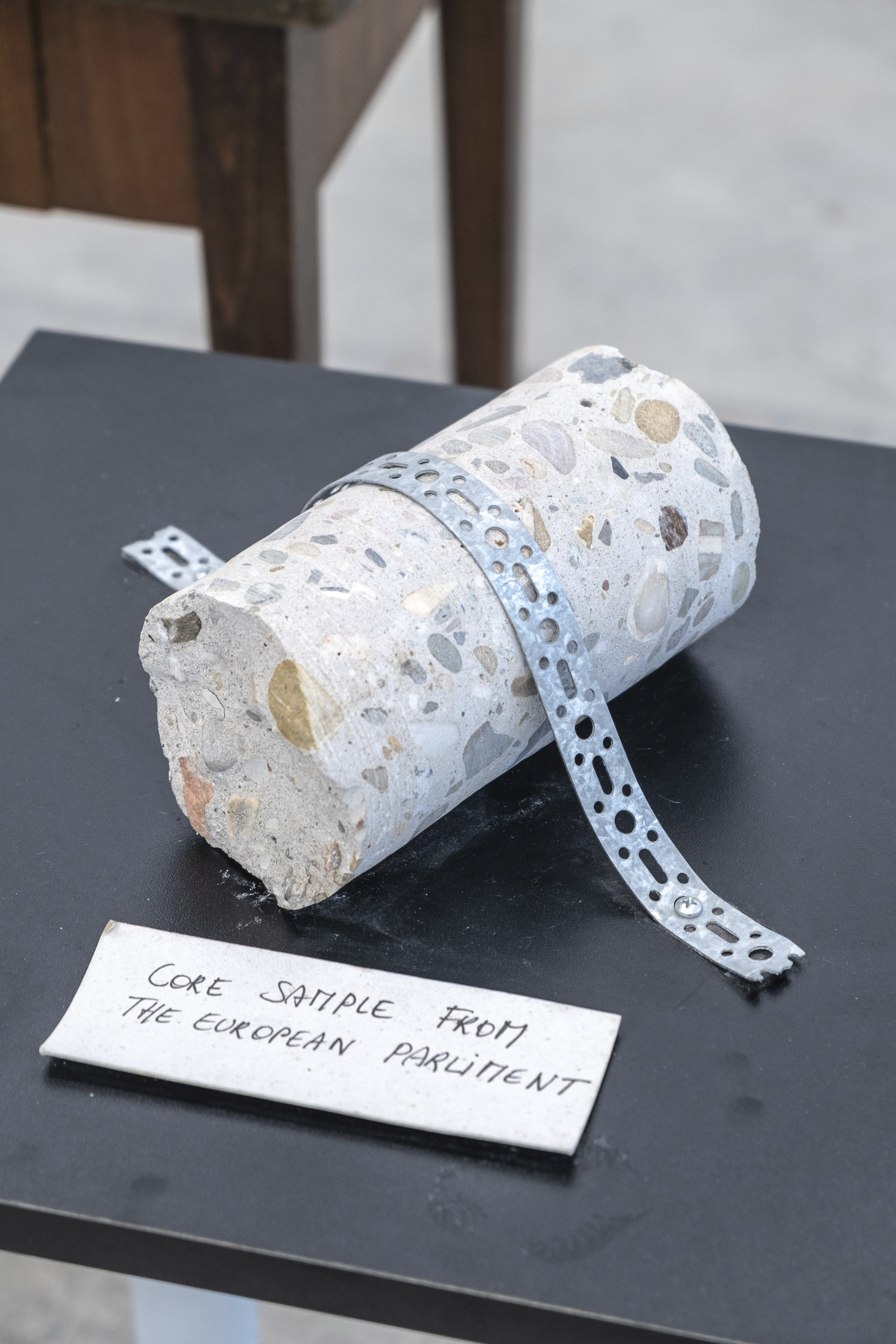Jimmie Durham

Painted Self Portrait, 2007
Mixed media: C‑print, paint
83.5 × 61 cm
Courtesy Christine König Galerie, Vienna
Jimmie Durham (*1940 Washington, Arkansas, lives in Berlin and Rome) works with associative attributions and lyrical ideas that he translates into fragile sculptures and humorous assemblages. Sometimes he also grapples with the artistic genre of the self-portrait, while adopting a critical position toward it. He sees the self-portrait as a strange project to which a certain egocentricity clings, because the subject usually amounts to nothing more than an illustrative of one’s own person. In his own self-portraits, Durham searches for alternative forms of self-representation.
The work Painted Self Portrait (2007) consists of a passport-like photograph of the artist, which he has painted over with yellow and red stripes so that his face is no longer recognizable. In the structures of bureaucracy and the nation-state, photographs of oneself generally represent an important basis for proving one’s own identity. Durham is, however, taking aim at common control mechanisms whose goal is to pin down a person’s status and raising the question of cultural identity. Overpainting his face has parallels to the face painting of various indigenous groups, with which Durham expresses a hybrid cultural origin and questions, in the spirit of an ironic antiessentialism, the validity of national and ethnic belonging. Durham himself plays with a (partial) identity as Native American, which has repeatedly been called into question and was recently denied by official representatives of the Cherokee tribes based on birth records that indicate otherwise. The colorful stripes remind of the visual power of national flags but without pointing to a specific nationality; rather, Durham mischievously rides roughshod over the symbolisms of national or institutional membership and calls for reductive unity.
Durham’s self-portrait raises questions of identity and belonging. His thinking behind it rejects simplifying attributions of identity and develops an approach that stages in a trickster-like way diversity, hybridity, and cosmopolitism without simple categorizations.

Three Stones (Core Sample from St. Peter’s Cathedral, Core Sample from European Parliament, Bierstein), 1996
Stone, wood, metal, text on paper
83 × 30 × 27.5 cm; 86 × 60.5 × 44.5 cm; 80 × 40 × 40 cm
Courtesy Christine König Galerie, Vienna
Jimmie Durham often works with common objects and discarded items, which he then places in a narrative relationship to his detailed and almost fluid objects in order to relate his story and lyrical view. Another aspect of his artistic practice is the use of stones, which have preoccupied him since childhood.
Classically, a museum presentation of objects always includes the pedestal, which is supposed to promise a certain dignity to the things being exhibited and to make them status objects. By contrast, Durham’s three-part installation Three Stones (1996) presented here conveys an impression of nonchalance. To do so the artist employs three stone samples as well as a stoneware beer stein and places each of these objects on a used side table.
The cylindrical pieces of stone represent so-called core samples, one of which was taken from the European Parliament while the other is from St. Peter’s Cathedral in Rome. Both buildings are very important to the European self-image. That only makes even more surprising the selection of the objects and the way Durham has chosen to present them to refer to these institutions. The artist distances himself from getting lost in the superficiality of the façade and employing such stately materials as glass or marble panels. Instead, he drills down deeply to get at the core of the buildings. To represent the European Parliament, Durham uses a piece of terrazzo, a material familiar since antiquity composed of many separate pieces of stone held together by a binder. In the case of St. Peter’s Cathedral, it is obvious that it is a very old stone that is beginning to crumble.
The constitution of the core samples thus symbolizes various forces that are important to Europe’s cultural identity. By comparison, the beer stein used and the word “Bierstein” on the table seem strange. The stoneware beer stein recalls brewing and popular culture — two forces that are also deeply anchored in the self-image of the culture and that humorously undermine the weighty significance of the other two pieces in the installation. Moreover, the custom-made embodiments of parliament and church appear to fit perfectly into the opening of the beer stein. That calls to mind an excessive culture of conversation that has developed around the discourse on Europe.
Jimmie Durham
has exhibited in solo shows at Fidelidade Arte, Lisbon; Culturgest, Porto; the d’Art Contemporain, Villeurbanne / Rhône-Alpes; the Fondazione Adolfo Pini, Milan; the Hammer Museum, Los Angeles; the Whitney Museum of American Art, New York; the Migros Museum für Gegenwartskunst, Zurich; the Museo nazionale delle arti del XXI secolo, Rome; the Museo Querini Stampalia, Venice; the Serpentine Gallery, London; Parasol Unit, London; the Museum of Contemporary Art, Vigo; the Visual Arts Foundation Middleburg; the Bari Teatro Margherita, Bari; the Fundazione Morra Greco, Athens; and the Palazzo Reale, Napoli.
Works by Durham have also been included in group exhibitions at the Museum of Contemporary Art Antwerp, Antwerp; Kunsthalle Charlottenborg, Copenhagen; Montpellier Contemporain, Montpellier; the 58th Venice Biennial, Venice; the Museo nazionale delle arti del XXI secolo, Rome; the Museo d’Arte Contemporanea Donnaregina (MADRE), Madrid; the Villa Medici – Académie de France à Rome, Rome; the Whitney Museum of American Art, New York; the 6th Moscow Biennial of Contemporary Art, Moscow; and dOCUMENTA (13), Kassel.